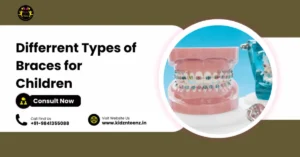Permanent teeth are the second set of teeth that replace the primary (baby) teeth and are meant to last a lifetime. These teeth begin to emerge during childhood and play a crucial role in chewing, speaking, and overall dental health. Unlike baby teeth, permanent teeth are meant to last a lifetime and remain in place through adulthood. The age at which these teeth begin to erupt varies, but understanding the permanent teeth eruption age is essential for parents and caregivers to monitor their child’s dental development.
Types of Teeth: Primary vs Permanent
Children start their dental journey with 20 primary (baby) teeth that eventually fall out, making way for 32 permanent teeth. Understanding the Permanent Teeth Eruption Age, including specific stages like Permanent canine eruption age and second molar eruption age, helps parents track oral development and spot early issues in alignment or spacing.
- Incisors: Incisors are the flat, sharp-edged teeth at the front, used for cutting food. Primary incisors usually appear between 6–12 months, while permanent ones emerge between ages 6–8. Tracking the Permanent Teeth Eruption Age of incisors helps ensure timely replacement and detect delayed tooth shedding or eruption patterns.
- Canines: Canines are pointed teeth beside the incisors, designed for tearing food. In children, they emerge around 16–20 months, and the Permanent canine eruption age typically ranges from 9–12 years. Monitoring this stage ensures proper spacing and helps orthodontists anticipate crowding or jaw alignment issues early.
- Premolars: Premolars replace the baby molars and appear between ages 10–12. They help crush and grind food efficiently, supporting chewing balance. Their appearance marks an important Permanent Teeth Eruption Age milestone, ensuring a smooth transition from primary to permanent dental structure and maintaining facial proportion.
- Molars: Molars handle the heavy work of grinding food. Primary molars appear by age 2, while permanent molars emerge without replacing any baby teeth. The second molar eruption age is generally between 11–13 years, playing a key role in jaw growth, bite stability, and overall oral function.
By tracking Permanent Teeth Eruption Age, Permanent canine eruption age, and second molar eruption age, parents can ensure that their child’s oral development remains on schedule, minimizing future orthodontic complications.

When Will My Child’s Permanent Teeth Come Through?
When your child’s Permanent teeth eruption age come through is a key milestone in their growth, typically starting around age 6. This transition from baby teeth to permanent teeth continues gradually and concludes by age 12 or 13. Recognizing this timeline allows parents to track dental development and address any potential concerns early.
General Timeline for Permanent Teeth Eruption
| Tooth Type | Primary Teeth (Baby Teeth) – Eruption Age | Permanent Teeth (Adult Teeth) – Eruption Age | Remarks |
| Central Incisors | Lower: 6–10 months Upper: 8–12 months | Lower: 6–7 years Upper: 7–8 years | First permanent front teeth to erupt. |
| Lateral Incisors | Lower: 10–16 months Upper: 9–13 months | Lower: 7–8 years Upper: 8–9 years | Erupt shortly after central incisors. |
| Canines (Cuspids) | Lower: 17–23 months Upper: 16–22 months | Lower: 9–10 years Upper: 11–12 years | Permanent canine eruption age is typically around 9–12 years. |
| First Molars | Lower: 14–18 months Upper: 13–19 months | Lower: 6–7 years Upper: 6–7 years | First permanent molars mark major jaw growth. |
| Second Molars | Lower: 23–31 months Upper: 25–33 months | Lower: 11–13 years Upper: 12–13 years | Second molar eruption age ensures proper bite formation. |
| Premolars (Bicuspids) | (No primary premolars) | First: 10–11 years Second: 10–12 years | Replace primary molars; aid in chewing efficiency. |
| Third Molars (Wisdom Teeth) | (Not present in primary set) | 17–21 years | Last to erupt; often need removal due to crowding. |
It’s important to remember that each child’s eruption timeline can vary slightly, but regular dental trauma visits will ensure their teeth come in properly.
Using a Permanent Teeth Chart
A permanent teeth chart is a valuable tool for tracking the development of your child’s dental health. By referencing the chart, parents can gain a clearer understanding of when different permanent teeth are expected to erupt and ensure proper dental care at each stage of growth.
- Tracking Eruption Age: The chart helps parents track the permanent teeth eruption age, ensuring that teeth are emerging on schedule. Typically, permanent teeth begin erupting at age 6, with most appearing by age 12.
- Identifying Baby Gums Before Teeth Erupt: The chart also highlights what to expect from baby gums before teeth erupt. Swelling or slight discomfort in the gums can indicate that a tooth is ready to emerge.
- Permanent Canine Eruption: By using the chart, parents can identify when permanent canines are expected to erupt, usually between ages 10 and 12. This helps in monitoring alignment and the overall progression of teeth.
- Second Molar Eruption Age: The chart marks when second molars typically emerge, between ages 11 and 13. This stage completes the child’s set of permanent teeth, improving chewing efficiency.
Utilizing a permanent teeth chart allows parents to monitor each eruption phase, ensuring a healthy dental development process and providing a clear guide for dental care during these transitions.
Caring for Your Child’s New Teeth
As your child’s Permanent teeth eruption age start to come in, it’s essential to care for them properly to ensure lifelong dental health. Establishing good oral hygiene early on sets the foundation for lifelong healthy teeth.
- Brush Regularly: Start brushing your child’s teeth twice a day with fluoride toothpaste as soon as the first permanent teeth appear, around age 6. This prevents cavities and promotes healthy enamel.
- Monitor Baby Gums Before Teeth Erupt: Before permanent teeth erupt, baby gums may swell or feel tender. Gently massaging the gums can ease discomfort and encourage healthy gum growth.
- Permanent Canine Eruption Age: At around age 10-12, permanent canines will emerge. Proper oral care ensures that these teeth align correctly.
- Second Molar Eruption Age: The second molars typically come through between ages 11 and 13. Regular brushing and flossing during this period help prevent cavities in these back teeth.
By following these steps, you can ensure your child’s teeth develop properly and stay healthy.
Baby Teeth Vs. Permanent Tooth Eruption In Children
The eruption of baby teeth and Permanent teeth eruption age differs significantly in timing and function. Baby teeth, also known as primary teeth, are temporary and begin to fall out around age 6, making way for permanent teeth. Recognizing these variations is important for monitoring your child’s dental growth and development.
- Timing: Primary (baby) teeth typically begin to appear around 6 months of age and continue to erupt until about 3 years old. Permanent teeth usually begin to emerge around the age of 6 and continue to develop until approximately age 12 or 13. This stage is called the permanent teeth eruption phase, typically starting with the emergence of the lower central incisors.
- Function: Baby teeth help in the development of speech, chewing, and maintaining space for permanent teeth. Baby gums before teeth erupt may appear smooth but swollen, indicating the upcoming eruption. Permanent teeth, on the other hand, are meant to last a lifetime and serve in all aspects of oral function, 2nd molar eruption age including chewing and alignment.
- Number of Teeth: Children usually have 20 baby teeth, which are gradually replaced by 32 permanent teeth, including wisdom teeth. This total includes the emergence of molars and canines at later stages of dental development.
- Eruption Order: Baby teeth erupt in a fairly consistent order, beginning with the central incisors. Permanent canine eruption age typically occurs around 10 to 12 years old, and second molar eruption age happens between 11 and 13, completing the set of permanent teeth.
These differences highlight the crucial developmental phases in a child’s dental health, helping parents track the changes and care for their child’s teeth accordingly.
When Does Permanent Tooth Eruption In Children Occur?
Permanent teeth eruption age in children typically follows a predictable timeline, beginning around age 6. Key stages include:
- First Molars (Age 6): Erupt first, establishing a foundation for proper bite alignment.
- Central Incisors (Age 6-8): The lower front teeth (incisors) are usually the first to appear, followed soon after by the upper front teeth.
- Lateral Incisors (Age 7-9): These follow the central incisors, completing the front teeth row.
- Canines (Age 9-12): These pointed teeth are crucial for biting and begin to emerge after incisors.
- Premolars (Age 10-12): These teeth replace primary molars, aiding in chewing.
- Second Molars (Age 11-13): These come after the premolars, completing the upper and lower back teeth.
The baby gums prior to eruption form a soft and smooth surface, which gradually accommodates the new permanent teeth as they push through.
Delayed Tooth Eruption — When to Worry
Most kids follow a broad age of eruption of permanent teeth window, and a 6–12-month variation is often normal. Delayed tooth eruption becomes clinically relevant when a tooth is more than 12 months past the expected tooth eruption age, or when one side erupts but the contralateral tooth lags by over 6 months. Pain, swelling, or loss of space around the area are additional red flags that warrant timely assessment.
- Know the Baseline Timelines: Front incisors typically erupt between ages 6–8, premolars and canines between 9–12, and second molars at 11–13. These anchors are compared with the first tooth eruption age and the first molar eruption age to judge if development falls within the usual limits. Tracking against the deciduous teeth eruption age is equally important, as premature or delayed shedding of baby teeth often influences when permanent teeth appear.
- What’s Normal vs. Concerning in Gums: Mild swelling or a bluish “eruption cyst” on baby gums before teeth erupt is usually self-resolving. However, if the gum looks chronically inflamed, very tender, or shows recurrent abscess near a non-erupted tooth, the delay may indicate a pathological cause. Linking these findings with the expected tooth eruption age helps clinicians decide whether intervention is necessary.
- Asymmetry Matters: If a right canine erupts on time but the left is still absent after 6–9 months, this asymmetry suggests obstruction, ectopic eruption, or ankylosis. Persistent unilateral delay is often more predictive of problems than a generalized lag. Comparing such cases to the expected age of eruption of permanent teeth provides clarity on whether the delay is within normal limits or clinically significant.
- Local Dental Causes: Common causes include retained baby teeth, extra teeth (mesiodens), cysts, trauma, or arch space loss. These conditions interfere with the first tooth eruption age and can shift the eruption pathway. Monitoring the deciduous teeth eruption age is crucial, as premature loss without space maintenance often leads to blocked eruption of permanent successors.
- Systemic and Growth Factors: Endocrine issues such as hypothyroidism, nutritional deficiencies like vitamin D or calcium, and genetic syndromes may slow down the age of eruption of permanent teeth. When delays involve multiple teeth beyond the normal tooth eruption age, systemic conditions should be considered alongside local causes.
- Age Checkpoints to Watch: The permanent canine usually erupts at 10–12 years, and the second molar eruption age falls between 11–13 years. The first molar eruption age, around 6 years, is a critical benchmark, as space created by these molars influences how subsequent teeth erupt. Absence of a palpable canine bulge by age 11 or molars failing to erupt on schedule can signal impaction or crowding.
- Space is Everything: Losing a baby molar early without a space maintainer lets neighbors drift, physically blocking successors. Tracking both deciduous teeth eruption age and first molar eruption age ensures timely intervention. Preserving space supports smooth eruption and prevents orthodontic complications.
- How Clinicians Assess: Dentists palpate eruption paths, evaluate arch length, and review exfoliation history. Imaging, including panoramic radiographs or CBCT, confirms tooth presence, position, and obstruction. The findings are always measured against the first tooth eruption age and the general age of eruption of permanent teeth to determine whether the eruption is delayed or within variation.
- When to Act vs. Monitor: Physiologic delays with clear eruption paths can be safely monitored. However, obstructions, severe crowding, or ectopic/impacted teeth may require extraction of retained primary teeth, orthodontic space regaining, or surgical exposure. These decisions are guided by comparing actual eruption to the expected tooth eruption age.
- Interceptive Orthodontics Helps: Expansion of a narrow maxilla, regaining lost space, and eruption guidance can turn a potential impaction into a normal pathway. Acting before the first molar eruption age and aligning treatment with the natural age of eruption of permanent teeth shortens orthodontic treatment time and protects periodontal health.
- Home Monitoring That Works: Parents should track which baby teeth were lost and when, noting pain, swelling, or delayed eruption in specific areas. If months pass beyond the first tooth eruption age or deciduous teeth eruption age with no progress, or if speech and bite are affected, a pediatric dental evaluation is recommended.
- When to Worry — Clear Triggers: A tooth more than 12 months late versus its expected tooth eruption age, contralateral asymmetry beyond 6–9 months, absent radiographic tooth, or signs of obstruction/infection all justify prompt action. Recognizing these delays early preserves space, guides eruption, and ensures the child’s smile develops within the natural age of eruption of permanent teeth.
Are baby teeth important if they don’t last?
Although baby teeth are temporary, they play a critical role in a child’s overall oral development and long-term dental health. They not only assist in early speech and chewing but also serve as essential placeholders for the proper alignment and eruption of permanent teeth.
- Guidance for Permanent Teeth Eruption: Baby teeth maintain the necessary space in the jaw for permanent teeth, ensuring they erupt in the correct position. When a baby tooth is lost prematurely, it can lead to misalignment or crowding issues treatment, especially around the average permanent teeth eruption age of 6 to 12 years.
- Health of Baby Gums Before Teeth Erupt: The condition of the gums before tooth eruption significantly affects how smoothly baby and later permanent teeth come in. Healthy baby gums create a supportive environment for both primary teeth eruption and the eventual emergence of permanent teeth.
- Importance in Speech and Nutrition: Baby teeth are vital in helping children develop clear speech patterns and chew food effectively. Losing these teeth too early can interfere with proper jaw development and nutritional habits.
Role in Eruption of Permanent Canines and Molars: Permanent canine eruption typically occurs between ages 9 and 12, while second molars emerge between ages 11 and 13. Retaining baby teeth until these ages helps preserve space and ensures the proper timing and sequence of eruption, reducing the risk of orthodontic complications.
Will the Cap Affect the Adult Tooth Eruption?
- A cap on a primary tooth protects it until natural shedding and usually does not disturb the permanent teeth eruption age, as adult teeth follow their natural path.
- Concerns about baby gums before teeth erupt are common, but caps do not change gum health or eruption space when monitored regularly.
- The permanent canine eruption age (9–12 years) may require cap removal on primary canines to guide proper alignment as adult canines emerge.
- For molars, the second molar eruption age (11–13 years) is rarely delayed by caps; dentists adjust or remove them if spacing issues arise.
Conclusion
Permanent teeth eruption age is a gradual process that occurs over several years. It begins around age 6, with the first molars, and continues until the late teenage years, with the eruption of wisdom teeth. Understanding this process is essential for ensuring proper dental care and addressing potential issues early. Regular dental checkups during this period can help monitor the eruption and guide proper oral development.
Read also: What Causes Bad Breath




